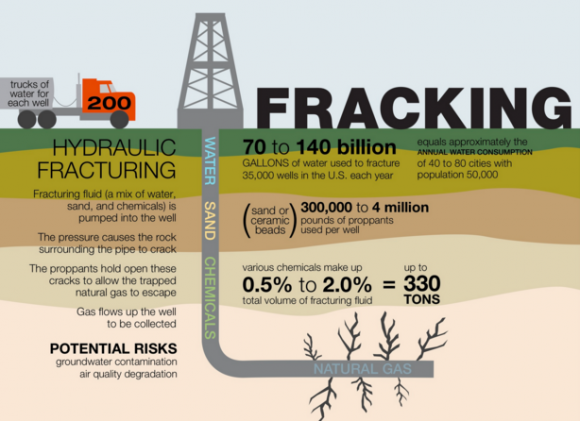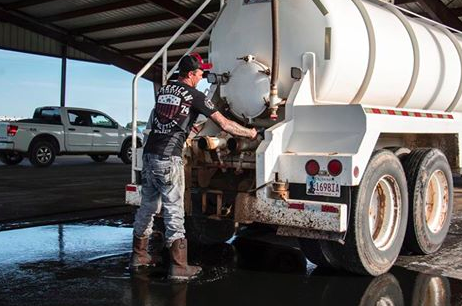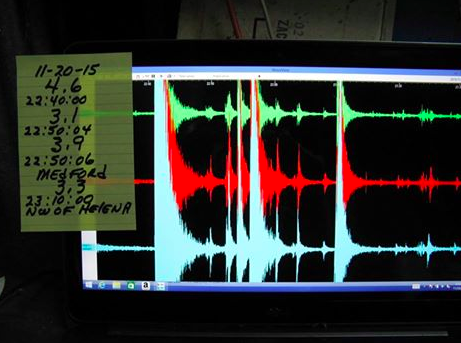aNewDomain — In this buckle of the Bible Belt, earthquakes are not Acts of God. And they seem to be multiplying.
In the last seven years, there have been 5,000 earthquakes in the state of Oklahoma. That’s new. U.S. Geological Survey (USGS) officials say Oklahoma is now shaking harder than California and warn residents that they’d better start preparing for “the Big One,” a 6.0 or larger quake capable of killing and injuring thousands by leveling urban areas and disrupting critical infrastructure like energy and power grids.
 “Underneath any of (Oklahoma’s) urban areas, whether it’s Stillwater, Cushing, Oklahoma City or Guthrie, these cities are not built to seismic standards. They’re not … L.A.,” Oklahoma State University hydrogeophysicist Todd Hallihan said last week. “It’s unclear exactly how high we might go, (but) the predictions (for the Oklahoma “Big One”) are (in the) upper 5 to 6.0 range.”
“Underneath any of (Oklahoma’s) urban areas, whether it’s Stillwater, Cushing, Oklahoma City or Guthrie, these cities are not built to seismic standards. They’re not … L.A.,” Oklahoma State University hydrogeophysicist Todd Hallihan said last week. “It’s unclear exactly how high we might go, (but) the predictions (for the Oklahoma “Big One”) are (in the) upper 5 to 6.0 range.”
There is, many scientists believe, a manmade explanation for the spate of quakes cracking walls, driveways and foundations all over this sprawling state bordering Texas, Arkansas, Colorado, Kansas and Missouri.
That connection is fracking. Or, to be more specific, the pumping of large amounts of waste water into the earth’s crust in order to access embedded natural gas and oil.
The fracking connection
Hydraulic fracturing — that is, fracking — is the increasingly popular practice of extracting shale gas from the earth’s crust. The process involves drilling deep into the earth and then shooting salty wastewater at the shale rock to release the gas within.
The injection of water, sand and various chemicals at high pressure lets the gas flow out to the well, a procedure that is probably the cause of Oklahoma’s new notoriety as the country’s earthquake capital, seismologists at the USGS and elsewhere say. The increase in fracking over the last several years directly corresponds to Oklahoma’s passing California this year as the most seismic region in the continental U.S.
Just a decade ago, though, the state was near the bottom of the list.
Energy companies have been slow to buy into accusations that fracking water injections and earthquakes are linked, analysts say. According to this investigative report in Bloomberg, petrochemical industry execs pressured scientists about publicly making the link, an accusation that the oil companies involved squarely deny.
 What no one can deny is just how critical the petrochemical industry and its recent massive profits have meant for Oklahoma. It employs fully one in five Oklahomans at this writing.
What no one can deny is just how critical the petrochemical industry and its recent massive profits have meant for Oklahoma. It employs fully one in five Oklahomans at this writing.
No quick off switch
In November 2011, Oklahomans got their first real taste of the sort of temblors California spends millions to prepare for annually. That month, two quakes, rated at 4.8 and 5.0 respectively, slammed Prague, OK and were felt for hundreds of miles around.
As recently as 2008, Oklahoma averaged one or two small quakes of 3.0 or more a year, a number that has since increased to hundreds a year from June 2014 to June 2015, which led the oil and gas regulating Oklahoma Corporation Commission (OCC) to announce Oklahoma as the “earthquake capital of the world.” In July ’14, in fact, the USGS recorded one of the most significant quakes in state history east of Oklahoma City: a 5.6 magnitude shaker.
The statewide spike over the last year is a “game changer,” OCC reps said. The agency cracked down on wastewater injection wells but the changes so far have had little effect to curb the seismic activity.
According to National Earthquake Information Center’s David McNamara, near total stoppage of wastewater injection could sharply reduce earthquake frequency and severity. But many observers question whether the OCC has gone far enough to shutter wells — or waited too long to intervene. The fear is that there is no quick off switch.
Another fear has to do with the huge influence of the oil and gas industry here, and whether state officials are somehow slowing the process.
For instance, despite the frequent shaking any 10-year-old living here could attest to, the Oklahoma Geological Survey (OGS) has recorded only six individual earthquake sequences in Oklahoma over the same timeframe that the USGS recorded hundreds.
Angela Spotts, a co-founder of Stop Fracking Oklahoma, cut to the chase in EcoWatch, writing:
It really appears to me we are protecting the [oil and gas] industry in this state. Their jobs are important. But my home and all the people I speak for that don’t have the courage to stand up and speak out, our lives, homes, property and well-being is every bit as important as the jobs in the oil and gas industry. And I sincerely don’t believe the actions have been quick enough and fast enough and protecting … one of the big ones from happening.”
To curtail hazardous wastewater disposal and require reinforcing buildings to withstand induced earthquakes, the Sierra Club and Public Justice threatened to file a lawsuit in late October. The suit would potentially target four oil and gas entities, including NewDominion, Sandridge Exploration and Production, Chesapeake Operating and Devon Energy Production Company, alleging their wastewater disposal operations are causing hundreds of earthquakes in the State of Oklahoma in recent years.
The letter of intent to sue asserts the companies are routinely engaging in hydraulic fracturing and wastewater disposal in the state and are in violation of the Resource Conservation and Recovery Act (RCRA), which carries civil and criminal penalties due to the illegal disposal of hazardous chemicals contaminating the environment and endangering public health.
Recent cases prosecuted around RCRA and related environmental laws have been initiated by U.S. and state attorneys general. Generally, they are considered to be serious offenses. But Oklahoma doesn’t have an environmental division in its state attorney general’s office and the Office of the Oklahoma Attorney General has consistently defied the EPA in repeated litigation against the agency.
 In the interest of public safety, the leading environmental groups and private law firms have demanded that the industry have 90 days to modify operations to curb seismic activity, particularly in the Arbuckle range, or face federal legal action and imposition of emergency injunctive relief enjoining ongoing fracking and wastewater disposal operations.
In the interest of public safety, the leading environmental groups and private law firms have demanded that the industry have 90 days to modify operations to curb seismic activity, particularly in the Arbuckle range, or face federal legal action and imposition of emergency injunctive relief enjoining ongoing fracking and wastewater disposal operations.
The national mineral law firm, Stoel Rives Law Group LLC, has discounted the significance of the threatened litigation because “among the 170,000 Class II Underground Injection Wells, only 40,000 are waste fluid disposal wells for oil and gas operations. Further, the USGS reports that ‘[o]nly a small fraction of these disposal wells have induced earthquakes that are large enough to be of concern to the public.’”
“Oklahoma is literally being shaken to its core by the operations of these oil and gas companies,” said Paul Bland, who is the executive director of Public Justice. “There is a clear and present danger posed by these irresponsible operations. If the energy companies do not voluntarily take action to stop it, we will take them to court,” he added. The apparent aim of the legal consortium is to have a federal judge impose a moratorium on hazardous wastewater disposal practices statewide.
Attorney Poynter was recently watching the Miss America pageant two weeks ago and bemusedly appreciated Miss Oklahoma’s line, “From the state that has frequent earthquakes, I’m here to shake things up!“
Even the environmental activist, Erin Brokovich, has weighed in on the issue, inviting Oklahoma locals to email her at erin@brockovich.com if they’ve suffered earthquake damage or fear it. “I am here in Washington, D.C. working on drinking water issues,” she wrote on her official Facebook page, “but I think I need to start speaking up about this … enough is enough!”
Meanwhile, about the water …
In related environmental crises in neighboring states, Texas residents have expressed concerns about the quality of clean drinking water pumped from underground aquifers, though officials there stop short of linking fracking and groundwater contamination.
A state inspection showed that Palo Pinto County, Texas groundwater tests revealed excessive levels of methane, chlorides and the ultrahazardous chemical benzene which may be cancer-causing. Because a neighboring water well was also found heavily contaminated with fracking-related chemicals, state inspectors believed that there in fact was a potential explosive threat.
These findings are consistent with filings in the U.S. Patent Office entered by drilling companies conducting fracking operations, like:
“Hydro-fracturing generates huge quantities of wastewater. Hydro-fracturing fluids which are injected into a well may contain chemicals that can be toxic to humans and wildlife, including chemicals that are known to cause cancer. These include substances such as: diesel fuel, which contains benzene, ethylbenzene, toluene, and xylene. Some of these chemicals, such as benzene, are considered carcinogenic at very low concentrations,” according to U.S. Patent No. 8,158,097. There are also more than a dozen other fracking-related patent applications with specific references to cancer and pollution.
State and U.S. officials are even quicker to deny the potential link between fracking and drinking water contamination than they are the connection to earthquakes, though.
In March. U.S. Sen. Jim Inhofe (R-OK), the ranking member of the United States Senate Committee on Environment and Public Works, introduced S.828, entitled “The Fracturing Regulations are Effective in State Hands (FRESH) Act.” The bill staunchly denies any occurrence of groundwater contamination in Oklahoma due to fracking operations, reading in part:
“Since 1949, my state of Oklahoma has led the way on hydraulic fracturing regulations, and just like the rest of the nation, we have yet to see an instance of ground water contamination.”
Sen. Inhofe and Oklahoma Attorney General Scott Pruitt are both notorious opponents of environmental regulations. At the beginning of his term in 2011, Pruitt abolished the Environmental Division of the Office of the Oklahoma Attorney General. In 2012, Inhofe released his book entitled “The Greatest Hoax: How the Global Warming Conspiracy Threatens Your Future,” a book that claimed that the United Nations invented the idea of global warming in order to ‘shut down the machine called America.’”
Despite this apparent disdain of environmental quality by the state delegation, Oklahoma has one of the greatest natural resources in the world. The state overlies the Ogallala Aquifer, the largest aquifer in the world. Some 82 percent of the residents of the midwest states, including Oklahoma, consume their drinking water from the enormous aquifer.
Following startling revelations in the documentary,“Gasland,” Congress commissioned a long-term study on whether fracking is environmentally unsound to underground water, which Inhofe supported. And in June of this year, the EPA released a five-year draft of its study that “did not find evidence that these mechanisms have led to widespread, systemic impacts on drinking water resources in the United States.”
That report, said Inhofe, “is the latest in a series of failed attempts by the administration to link hydraulic fracturing to systematic drinking water contamination. The Obama administration is now zero for four.”
But then the Annenberg Public Policy Center fact-checked Inhofe’s claim that showed “specific instances” have occurred where fracking contaminated drinking water resources — including drinking water wells — which refutes the Oklahoma Senator’s claim that there have been no instances of contamination.
Furthermore, a peer-reviewed study in 2014 concluded that drinking water wells near fracking sites in Texas and Pennsylvania were contaminated “with methane that had the chemical signature of gas normally found only deep underground,” according to Professor of Earth System Science Rob Jackson who co-authored the study, adding that “drilling that uses hydraulic fracturing has ‘contaminated ground waters through chemical and wastewater spills, poor well integrity, and other pathways.’”
Environmental groups that have warned about fracking for years said the EPA study proved the danger to the state’s drinking water, though they complained the report appeared incomplete and heavily influenced by the energy industry. Thomas A. Burke, the EPA’s science advisor, countered detractors, however, claiming that “it is the most complete compilation of scientific data to date, including over 950 sources of information, published papers, numerous technical reports, information from stakeholders and peer-reviewed EPA scientific reports.”
Gretchen Goldman, chief analyst for the Center for Science and Democracy at the Union for Concerned Scientists, told The Guardian this summer that the study “was nothing ‘more than a literature review,’” and demanded that the industry divulge greater data.
Notably, the EPA has declined requests for interview about the fracking report.
For aNewDomain, I’m Jim Kelly.
Inside photos: Redactie.dvhn.nl by Liselotte Schüren/Dagblad van het Noorden, All Rights Reserved. Fracking infographic: BBC, All Rights Reserved.













